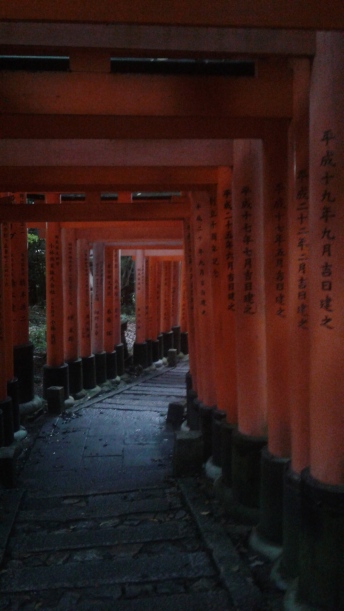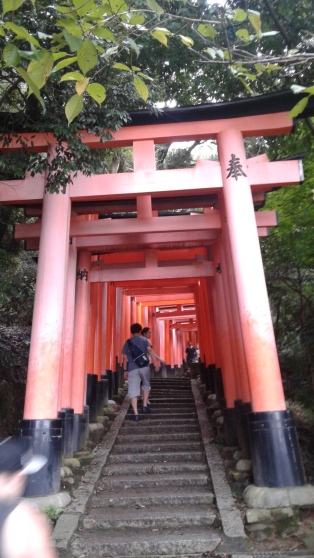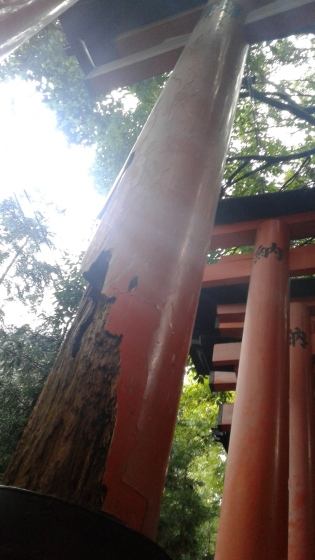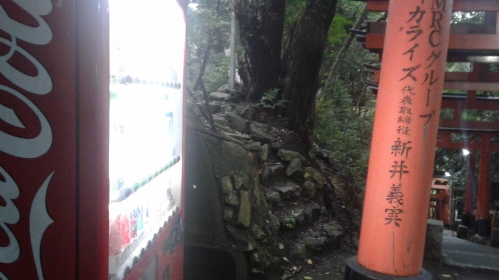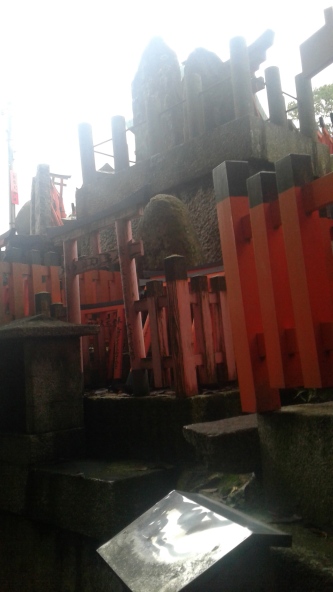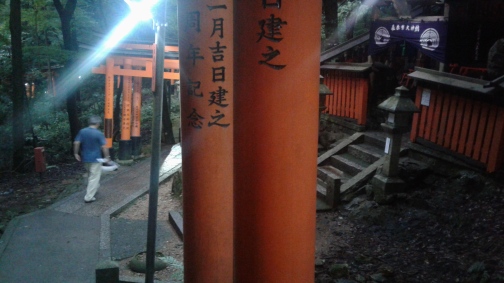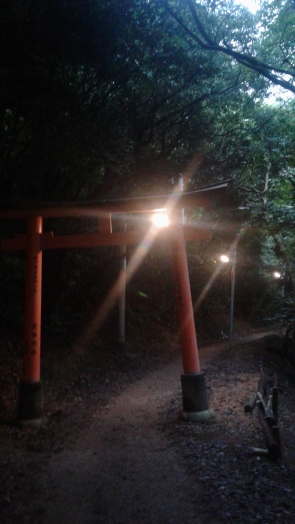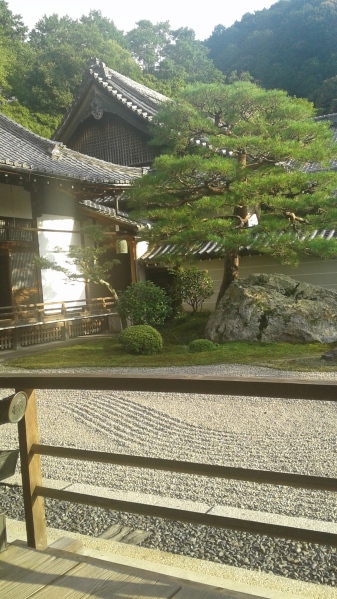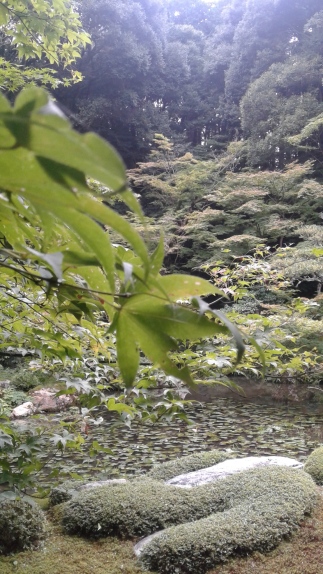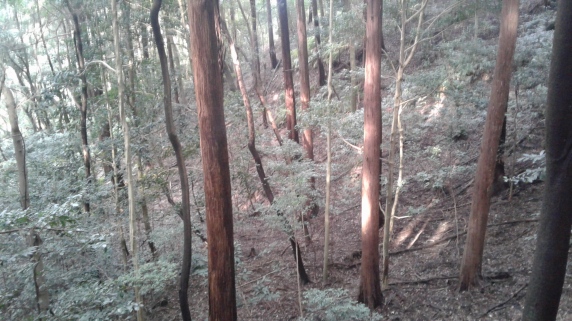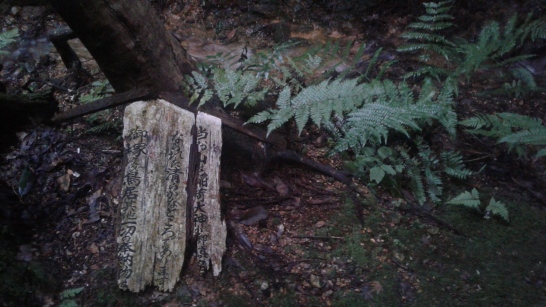Sept. 19, 2016
Another irksome day scrambling to dry bedsheets and quilt covers for check-ins. All three of us volunteer staff were stressed and frustrated. Back sore from sleeping on bottom bunk (which is really nothing more than a thin mattress on the tatami floor). No headache today though, thank goodness. Feet already sore before I even got out the door to do exploring in late afternoon. Walking shoes not broken in yet.
Successfully used subway to access Fushimi Inari. At first the path had many people on it, but as it approached the top it thinned out considerably. Many, many, many torii, and many shrines interspersed almost like checkpoints along the path. Across from the shrines were shops serving food, drinks, souvenirs, candles, good luck charms. Vending machines too.
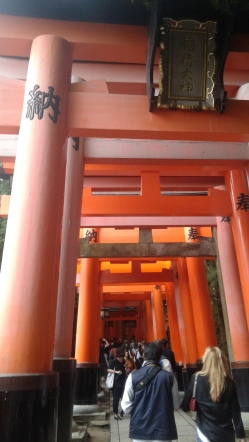
Torii are traditional Japanese gates that mark the borders between the mundane (and profane) world, and the sacred one.
Many little shrines clustered together, replete with candle holders, an altar for an offering (some of which had little tetra packs of juice, milk or coffee–even a can of Asahi beer on one of them), and a slab of stone as the centrepiece with kanji written on it. Many of them covered over with green moss. Kittens and cats roaming the grounds freely.
The shrines were also accompanied by kitsune, or foxes, which guarded the shrine, and acted as messengers for the god Inari.
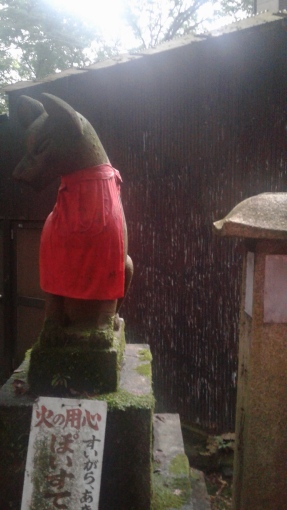
According to Japanese folklore kitsune possessed supernatural powers and great wisdom. They were even said to be able to shape shift into human form.
The repetitive nature of the pathway I was following had a hypnotic effect which put me for brief moments, in what I think is the best mindset for walking such paths. A mindset in which you become more receptive to the numinous. The immanent spirit of this place which is the sum total of the forest, the shrines, the cats, the wind as it sighs through pine and bamboo, the electric silence, punctuated by droplets falling from torii after rain. The genius loci, Inari.
Or at least I wanted to have that mindset, though the touristic part of my brain, and the over-analytical side to counter that, both together made such a feeling of reverence shallow. I wanted too many things at once, and my desires all cancelled each other out, and became burdensome, more than anything. Of course, I was projecting my own ideas on the place. I don’t even know how Japanese people feel at their own shrines, with what attitudes they approach them. Possibly nothing like mine. Inari is the Kami of rice, tea, sake, agriculture, industry, and success in worldly affairs. Hardly what a Westerner would imagine a divine being caring about. But here, the sacred and the humdrum may not be so separate as some “spiritual types” would like it to be. In the past, people have prayed to gods (including Jesus) and saints for safe passage, success in a new venture, incl. business, war, etc. This is nothing new, and not so unfamiliar as one may first suppose. You just have to take off your secular specs. Religion has always to some extent relied on commerce. Yet all the same, to me this place was enchanting, even otherworldly.
The larger shrines looked almost like cemeteries. Kept trying to get a good photo of the big spiders that made their homes above our heads, off to the sides, between the torii. And then there was the sound of the crows, that to me sounded like mad old men laughing. The cricket. A distant horn blowing from a distant temple, mingled with the sirens from the city down below.
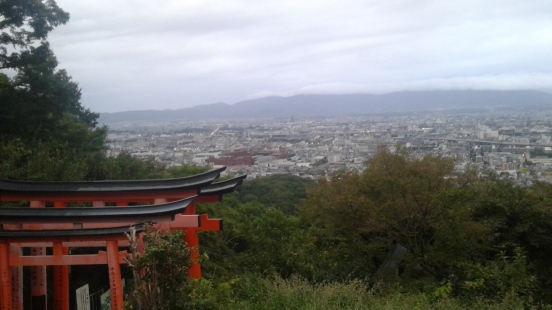
A view of Kyoto from halfway up Fushimi Inari. If the trees on the left weren’t there you could make out the distant towers of Osaka.
Caught wrong train north. Ended up at Kyoto Station, a half hour away from guesthouse. So I walked from there, stopped by a “family restaurant”, for an unglamorous but affordable dinner. Nervously ate my vegetarian meal, wondering if I was spoiling the mood by being there. Wondering if I was even eating the food correctly. Didn’t know what to do with the egg they gave me. Was it hard-boiled, or raw? Didn’t want to experiment and end up making a mess of things, so I the wrapped the egg in some napkins and slipped it stealthily into my bag. Only when I was about to leave did I see a man beside me crack his egg over his bowl of rice and stir it all together. So that’s what you do with it.
Though I was tense the whole time, proud of myself for going in, not listening to the urge to run straight home, just because it’s intimidating and spontaneous. Inexplicably I had a lot of energy by the time I got back to the guesthouse. Will have to go back to Fushimi Inari before I leave Japan.
Friday, Sept. 23, 2016
At Nanzen-ji
Sitting by the rock garden
To my left, a young man reading Kurt Vonnegut
Then, past the garden with the waterfall, beyond my sore feet,
past the cicadas and crickets, and the thick heat
The deep and pure tone of the bonsho
Calling me, taking my body and sounding me like a bell
Followed by a sutra wafting through the air
Tempting me with Old Shakyamuni’s mutterings

Nanzen-ji, which used to be a villa for the 13th century Emperor Kameyama, is one of the most famous Zen temples in Kyoto.
The temple roof’s tiles a steely blue in the sunset. The roof of the entrance hall an elegant black slope of Japanese cypress. The temple stands out in relief against the vibrant green forest billowing up behind it.
The red-pink frog in Emperor Kameyama’s pleasure garden, sitting absolutely zazen-still on the moss bed overlooking the pond.
Pseudo-Zen thoughts: What would the tree say if it could talk? It would say itself. It can only say itself. With every sway of branch and peel of bark and burst of flower. Just like you can only say yourself. You can’t not say it. It’s too late. Whether you want to or not. You’re saying it just by being alive, you are already an utterance, a phrase, a sentence on a page in a very, very, very large book. Even when you think you are hiding from the world, and perfectly silent, you are still saying yourself. So make a choice. What will your life-sentence be about?
Walking up the path to Mount Daimonji, walking right into a spider-web
Leaping, thrashing about, spitting, brushing myself off, praying to any local deity that nobody saw how much of an ass I just made of myself
Hoping I don’t see a killer hornet this far along the forest path.
Walking back, seeing a so-called “Samurai Musician” busker in a park. Drawing his shakuhachi flute like a katana, with ritualistic precision and ceremony. He plays to a moody and elegiac track on his speakers. He wears a wide-brimmed hat, like some wandering monk. He has a little dog with him, who also wears a wide-brimmed hat. Us tourists eat it up.
Saw a small Buddhist shrine by the subway station, and beside it a huge bundle of garbage and grocery bags on a bicycle. Its owner, woman, possibly homeless, nearby. So struck by this image. The shrine and the woman with her few worldly belongings. The symbol and reminder of compassion built next a person ignored by society. Honestly, felt the urge to take a picture, and resisted, disgusted with myself for having such an impulse. If I was a photographer documenting poverty for the purpose of raising awareness and combating it amid a callous and affluent society, I might feel more justified (although even then I would feel a strong ethical dilemma). But as things stand I’m just a tourist, a visitor in a country not my own. I don’t even know that woman’s situation; I’m projecting again. Regardless, whatever the striking juxtaposition, that’s still a person trying to get by. I don’t know if there’s a right way to be a tourist, but I’m certain there is a wrong way. That’s a line I hope to not cross.
Sept. 24, 2016
The days are passing me by. Finally cracked and bought Tales of the Heike from bookstore [Tales of the Heike is considered by Westerners to be a little bit like Japan’s Iliad]. Even though I told myself I wouldn’t buy books while I’m in Japan. It’s a slippery slope from here.
Saw two hawks dive-bombing for fish in Kamogawa. Some people driving down the street in go-carts, dressed as Mario and Luigi, and an amazing guitarist busking on Shijo-dori, playing an amazing instrumental version of Simon and Garfunkel’s El Condor Pasa. Went up to him after and praised his jaw-dropping guitar-work, and bought a CD of his. This place is magical.


